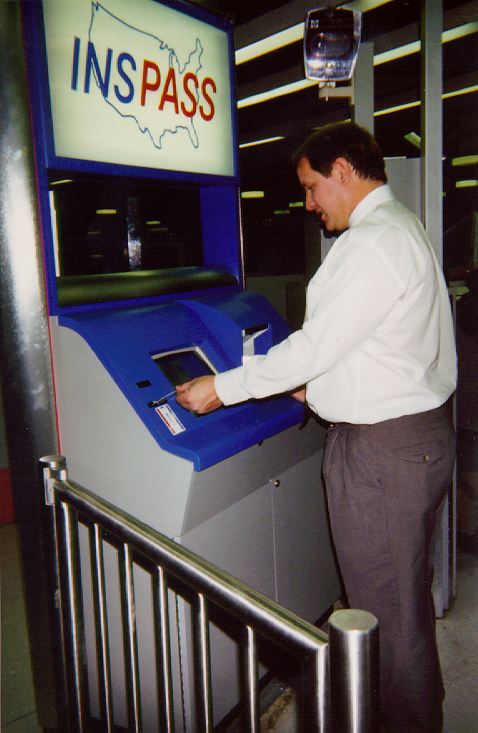INSPASS on:
[Wikipedia]
[Google]
[Amazon]
 INSPASS, or ''INS Passenger Accelerated Service System'', was a program of the
INSPASS, or ''INS Passenger Accelerated Service System'', was a program of the
CDSI
. Support for the program was later taken over by
Biometric Consortium: INS Passenger Accelerated Service System (INSPASS)
4 January 1996
Government Technology News: Consideration of INSPASS in Israel, August 2002Global Entry
{{DEFAULTSORT:Inspass History of immigration to the United States United States Department of Homeland Security Biometrics Expedited border crossing schemes
United States
The United States of America (U.S.A. or USA), commonly known as the United States (U.S. or US) or America, is a country primarily located in North America. It consists of 50 U.S. state, states, a Washington, D.C., federal district, five ma ...
Immigration and Naturalization Service (INS) during the 1990s and early 2000s the purpose of which was to facilitate the entry of pre-screened low-risk travellers through immigration and customs at certain airports.
Frequent travelers who were citizens of the U.S. or a handful of other trusted countries could apply for INSPASS privileges. After a background check, approved INSPASS members would register their hand geometry
Hand geometry is a biometric that identifies users from the shape of their hands. Hand geometry readers measure a user's palm and fingers along many dimensions including length, width, deviation, and angle and compare those measurements to measu ...
as a biometric
Biometrics are body measurements and calculations related to human characteristics. Biometric authentication (or realistic authentication) is used in computer science as a form of identification and access control. It is also used to identify ...
identifier and were presented with an associated membership card.
Upon entering the United States after arriving from abroad, users would subject themselves to hand geometry scans and would pass through Federal Inspection without undergoing a formal interview by immigration inspectors. The initial kiosk implementation, as defined by the U.S. Department of Justice, was composed of the following elements:
* ATM-like stand
* 80486 personal computer
* MS-Windows running Visual Basic
* 10 inch monitor/touch-screen
* 16-key keypad
* OCR-B
OCR-B is a monospace font developed in 1968 by Adrian Frutiger for Monotype by following the European Computer Manufacturer's Association standard. Its function was to facilitate the optical character recognition operations by specific electron ...
card reader
* Electronic gate lock trigger
* 5 inch Telpar receipt printer
* Recognition Systems, Inc (RSI) 'Handkey' hand geometry scanner
The program initially was established at JFK International Airport and Newark International Airport in May 1993. Later, it expanded to the US Immigration and Customs Pre-Clearance Inspection Stations in Toronto and Vancouver, Canada. Although modeled on the Dutch "SchipholPass" program, INSPASS was the first large scale biometric identity verification program undertaken by the United States Government and quickly became the largest biometric program in the world in terms of enrollments.
The development of the project was initially piloted and then later deployed with support from the John A. Volpe National Transportation Systems Center
The John A. Volpe National Transportation Systems Center or simply Volpe in Cambridge, Massachusetts, is a center of transportation and logistics expertise, operating under the United States Department of Transportation (U.S. DOT).
The Volpe C ...
and INS contractor Computer Data Systems, Inc.CDSI
. Support for the program was later taken over by
Electronic Data Systems
Electronic all cash BSN acc: 1311729000110205 Data Systems (EDS) was an American multinational information technology equipment and services company headquartered in Plano, Texas which was founded in 1962 by Ross Perot. The company was a subs ...
(EDS) in 1995 when they were awarded a general support services contract with the U.S. Department of Justice.Computer Data Loses Another Contract, Kathleen Day, Washington Post September 1, 1994
Program officials advocated the concept of "One Traveler, One Card" to promote harmonization of the system with other traveler biometric programs and regular meetings were held with the immigration authorities of Canada, the United Kingdom, Germany, Australia, and the Netherlands to achieve that goal. Pilots of land border versions were conducted in Buffalo, New York during the World University Games (summer 1993) and later in Hidalgo, Texas.
Eventually, a total of 15 permanent INSPASS kiosks were deployed at the following locations:
* New York (JFK) (6 terminals)
* Newark
* Toronto (2 terminals)
* Miami (2 terminals)
* Vancouver
* San Francisco
* Los Angeles (LAX) (2 terminals)
The program was discontinued in 2002. It has since been replaced by Global Entry
Global Entry is a program of the U.S. Customs and Border Protection service that allows pre-approved, low-risk travelers to receive expedited clearance upon arrival into the United States through automatic kiosks at select airports and via the S ...
, a program of the U.S. Customs and Border Protection that uses fingerprint biometrics to enable frequent travelers to bypass lines at traditional immigration inspection lanes at international airports.
See also
*Biometrics
Biometrics are body measurements and calculations related to human characteristics. Biometric authentication (or realistic authentication) is used in computer science as a form of identification and access control. It is also used to identify ...
* PORTPASS
* U.S. Customs and Border Protection
References
External links
Biometric Consortium: INS Passenger Accelerated Service System (INSPASS)
4 January 1996
{{DEFAULTSORT:Inspass History of immigration to the United States United States Department of Homeland Security Biometrics Expedited border crossing schemes